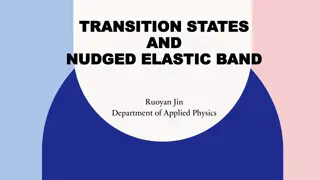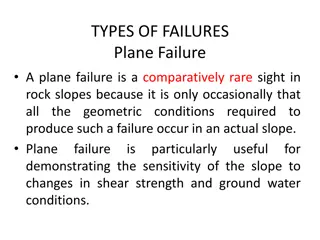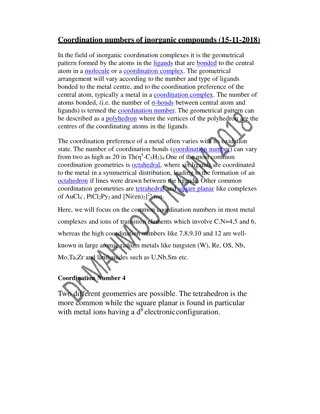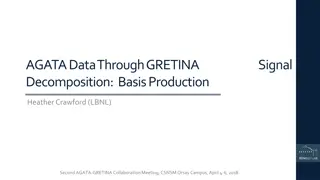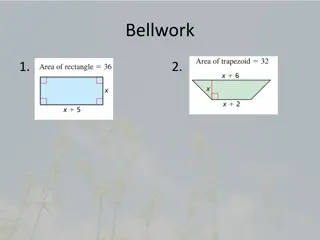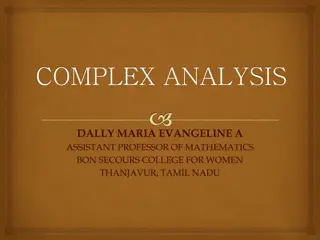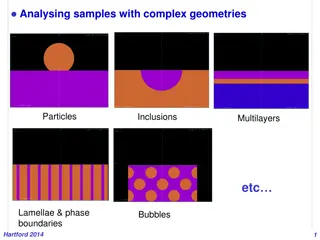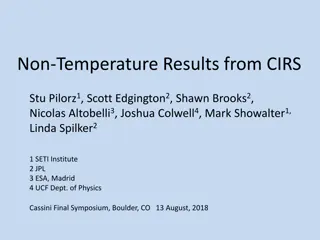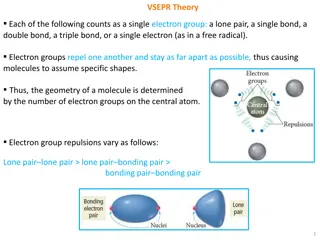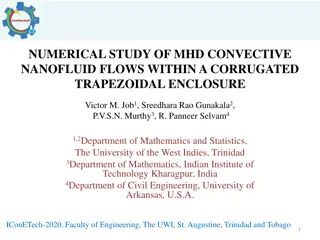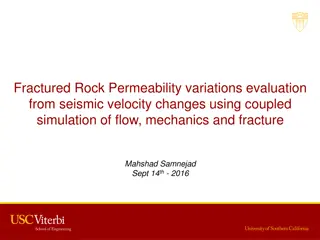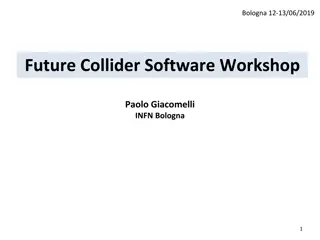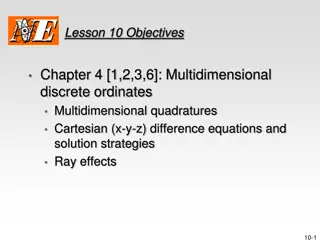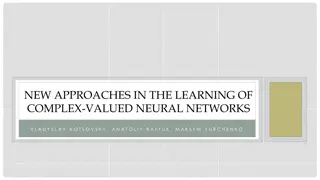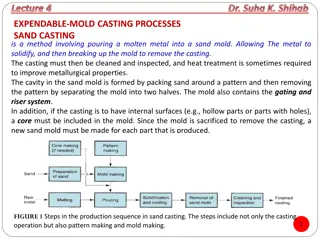Understanding Transition States and Nudged Elastic Band in Applied Physics
Description of transition states, potential energy surfaces, saddle points, minimum energy paths, and the Nudged Elastic Band method in the context of applied physics. The content explains key concepts such as transition states along reaction coordinates, the significance of potential energy surface
0 views • 9 slides
Understanding Capacitors in Physics
Capacitors are electronic components that can store electric charge and energy. This content covers various concepts related to capacitors, such as capacitance, charge storage capacity, electric fields between plates, and capacitance calculations for different geometries. Problems and examples are p
1 views • 46 slides
Understanding NMR Spectroscopy of Paramagnetic Molecules
NMR spectroscopy of paramagnetic molecules is influenced by the presence of unpaired electrons, leading to broadened spectra and complex coupling mechanisms. Quadrupolar nuclei, with spins greater than 1/2, play a significant role in the relaxation and splitting of NMR signals. The interaction betwe
0 views • 19 slides
Understanding Plane Failures in Rock Slopes
Plane failures in rock slopes are rare but significant, indicating sensitivity to changes in shear strength and groundwater conditions. Geometrical conditions must be met for such failures to occur, including specific alignments and interactions between the sliding plane and slope face. Analysis inv
0 views • 22 slides
Comprehensive Guide to Complex Numbers - Learning Objectives, Key Concepts, and Previous Knowledge Testing
This comprehensive guide provides detailed information on complex numbers, including learning objectives such as identifying complex numbers, applying algebra, understanding properties like conjugates and moduli, finding square roots, and representing in polar form. Key concepts covered include inte
3 views • 27 slides
Chemical Properties and Bonding in Xenon: A Study of Noble Gases
Noble gases, including xenon, exhibit unique chemical properties due to their stable electron configurations. Xenon forms compounds like xenon difluoride, xenon tetrafluoride, and xenon hexafluoride, showcasing various hybridization states and geometries. These compounds illustrate the reactivity of
0 views • 18 slides
Understanding Temperature and Friction in Metal Forming Processes
Metal forming processes are influenced by temperature and friction. At different temperature ranges, such as cold, warm, and hot working, the mechanical properties and forming behaviors of metals vary significantly. Cold working offers advantages like higher accuracy and strength, while warm working
0 views • 7 slides
Comprehensive Overview of Freezing Time Methods in Dairy Engineering
Neumann, Tao, and Non-Dimensional methods are key approaches for determining freezing times in unsteady state heat transfer processes in dairy engineering. The Neumann Problem, Tao Solutions, and Cleland and Earle Non-Dimensional Equation offer distinct equations and models to calculate freezing tim
1 views • 8 slides
Understanding the 18-Electron Rule in Transition Metal Organometallic Compounds
The 18-electron rule governs the stability of transition metal organometallic compounds by requiring the sum of metal d electrons and ligand-supplied electrons to be 18. This rule highlights the importance of electron count and ligand characteristics in forming stable complexes. Key concepts include
0 views • 15 slides
Exploring Hyperbolic Geometry and Tiling Patterns
Dive into the fascinating world of hyperbolic geometry, where angles in a triangle are less than 180 degrees and tilings exhibit negative curvature. Discover the beauty of the Hyperbolic Plane and learn about regular hyperbolic tilings characterized by Schlafli Symbols. Explore different models like
0 views • 46 slides
Exploring Texture Mapping in Computer Graphics
Delve into the world of texture mapping as a solution to the smoothness of polygons in computer graphics. Learn how to create textured scenes using techniques such as bump mapping and environmental mapping. Discover the process of representing textures, working with curved surfaces, and mapping onto
2 views • 24 slides
Exact Solutions in Cosmological Models Based on Teleparallel Gravity
Precision in cosmological models based on teleparallel gravity is explored, including fundamental theories, modifications, and applications in the context of General Relativity. The construction principles of GR modifications, characteristic tensors, relation between different metric-affine geometri
0 views • 17 slides
Coordination Numbers in Inorganic Compounds: Geometries and Structures
In inorganic coordination complexes, the coordination number refers to the number of atoms bonded to the central atom. Common geometries include octahedral, tetrahedral, and square planar, depending on the type and number of ligands. Transition metal complexes exhibit different coordination numbers
2 views • 8 slides
Understanding Coordination Chemistry: Structures, Isomers, and Naming
Exploring coordination chemistry involves understanding structures, isomers, naming conventions, and common coordination numbers, all essential in studying coordination compounds. Coordination compounds consist of central metals, ligands, and charge balancing ions. Naming involves listing cations, l
0 views • 46 slides
Understanding Electron Correlation and Basis Sets in Molecular Calculations
Polarized basis sets describe the electron density polarization in atoms and molecules to improve accuracy in computed geometries and frequencies. Diffuse basis sets are recommended for calculating electron and proton affinities. Electron correlations account for electron interactions in molecular c
0 views • 8 slides
Basis Production Procedure for AGATA through GRETINA Signal Decomposition
This presentation outlines the detailed procedure for generating basis signals in the context of AGATA data processed through GRETINA signal decomposition. It covers the generation of pristine basis signals, superpulse analysis, and the creation of cross-talk corrected basis files. The process invol
0 views • 19 slides
Understanding Multiple Scattering Programs in Fortran for Neutron Diffraction and Inelastic Analysis
Multiple scattering programs like MSCAT and DISCUS, written in Fortran since the 70s, are essential tools for neutron diffraction and inelastic analysis. These programs allow for the calculation of neutron cross-sections, scattering angles, and sample geometries. The results obtained include elastic
0 views • 8 slides
Fast and Robust Building Simulation Software for ASHRAE 90.1 Project
Carrying out an ASHRAE 90.1 project using performance rating method in Appendix G for a new office building in climate zone 5A. The software allows for efficient creation of baseline and proposed building geometries, comparison of building performance, and setup of air side systems. Utilizing dedica
0 views • 20 slides
Understanding Complex Numbers in Mathematics
Learn about complex numbers, including real and imaginary parts, operations with complex numbers, the imaginary unit, equality of complex numbers, and finding square roots of negative numbers. Explore how to define and use the imaginary unit, add, subtract, and multiply complex numbers, find complex
0 views • 17 slides
COMPLEX ANALYSIS
Complex analysis explores the properties and behavior of complex functions and numbers. Topics covered include functions of complex variables, limits, continuity, and differentiability. Understanding concepts like the Cauchy-Riemann equation is crucial in studying complex valued functions. This fiel
0 views • 9 slides
Exploring Complex Numbers in Mathematics
Delve into the world of complex numbers through solving quadratic equations with real coefficients that have complex solutions, extending polynomial identities to include factoring with complex numbers, rewriting expressions, and understanding imaginary numbers. Discover the process of finding compl
0 views • 16 slides
Understanding Coordination Complexes and Transition Metals
Today's lecture covers transition elements, coordination complexes, ligand types, geometries, naming, isomers, and bonding in coordination complexes. Transition metals form coordination complexes with metal ions, ligands, and counter ions. The types of ligands include monodentate and bidentate ligan
0 views • 24 slides
Advanced Simulation Techniques for Analyzing Samples with Complex Geometries
Explore the capabilities of PENELOPE simulation software for analyzing samples with intricate structures like particles, inclusions, multilayers, lamellae, and phase boundaries. The software facilitates detailed investigations of material composition and electron-photon transport in diverse geometri
0 views • 28 slides
Analytical Solutions for 2D Heat Equation with Separation of Variables
Consider the steady-state 2D heat equation with constant thermal conductivity. Analyze analytical solutions using separation of variables method for a square plate with defined boundary conditions. Learn how to express the general form of solutions and apply them to the heat equation in Cartesian ge
0 views • 15 slides
Understanding Different Geometries and Parallel Postulates
Explore the realms of Euclidean, Hyperbolic, and Elliptic geometries along with their unique characteristics, axioms, and the implications of the parallel postulates. Delve into the distinctions between these geometries and the intriguing concept of mixing Euclidean and Hyperbolic geometries within
0 views • 6 slides
Preliminary Mapping and Assignment of Geometries for Traffic Management Test Data
This document outlines the work timeline and analysis of a traffic management test data set, including the division of text into smaller blocks for easier analysis. It also provides a sample extract of mapped areas to be avoided and the assignment of geometries to the test data set, covering ship re
0 views • 10 slides
Understanding Water Influx in Oil and Gas Reservoirs
Water influx, a critical aspect in oil and gas production, involves the expansion and flow of water from aquifers into reservoirs due to pressure drops caused by fluid production. This phenomenon impacts the degree of pressure maintenance, which can occur through various mechanisms like active water
0 views • 25 slides
Non-Temperature Results From CIRS Research Symposium
Rings around Icy Moons are studied through detailed observations and analyses by a team of researchers from various institutions. The study focuses on the IR emissivity results, occultation observations, and beta factor analysis carried out using the CIRS instrument. The rings are noted to emit in a
0 views • 34 slides
Latest Developments in Interaction Region Study at FCC-ee Workshop
Fresh results and progress were presented at the FCC-ee (TLEP) Physics Workshop in 2015. Two different Interaction Point designs were discussed, one being a small crossing angle design without a crab waist, and the other a more ambitious 30mrad crab waist design. Chromaticity corrections and geometr
0 views • 34 slides
Understanding VSEPR Theory for Molecular Geometry
VSEPR theory explains how the arrangement of electron groups around a central atom determines the shape of molecules based on the repulsions between different types of electron groups. The geometry of a molecule is influenced by factors such as lone pairs, single, double, or triple bonds, and their
0 views • 16 slides
Numerical Study of MHD Convective Nanofluid Flows within Corrugated Trapezoidal Enclosure
Study investigates the influence of sidewall inclination angle and Eckert number on unsteady flow and heat transfer in alumina-water and SWCNT-water nanofluids within a trapezoidal enclosure. Motivation stems from the heat transfer enhancement in trapezoidal geometries compared to rectangular ones,
0 views • 19 slides
Computational Models of DNA Damage and Repair in Radiation Therapy
Various computational models are used to predict DNA damage and repair mechanisms induced by different radiation treatments, such as X-rays and protons. These models simulate physical and chemical interactions, DNA geometries, and repair kinetics to compare biological effectiveness. Different models
0 views • 17 slides
Advanced Manufacturing Processes Overview
The course MENG584 focuses on advanced manufacturing processes including traditional and nontraditional machining techniques. Material removal processes, machining accuracy, and surface finish considerations are highlighted. Various machining methods such as cutting, abrasion, thermal, chemical, and
0 views • 24 slides
Fast Simulation Details in MAENTOUCH Simulation by Giles Qu. and Pascal Vernin
MAENTOUCH Simulation by Giles Qu. and Pascal Vernin allows for fast simulations with small details like mu-metal wires, featuring expert contributions for validation and optimization using soft iron materials. The simulations cover various geometries, validation of computed stray fields, and combina
0 views • 14 slides
Advanced Divertor Investigations on NSTX-U Leading to FNSF
Experimentally investigate advanced divertors on NSTX to design an FNSF divertor, overcoming challenges of the standard divertor. Explore divertor performance through experimental studies and comparisons of different geometries. Detachment caused instability in the standard divertor is explained heu
0 views • 16 slides
Evaluation of Rock Permeability Variations Using Seismic Velocity Changes
Assessment of fractured rock permeability variations through seismic velocity changes using a coupled simulation of flow, mechanics, and fracture. The study discusses motivation, problem statement, challenges, existing approaches, advantages of the proposed approach, state-of-the-art, mathematical a
0 views • 27 slides
Future Collider Software Workshop in Bologna
Hosted in Bologna, the Future Collider Software Workshop aims to discuss the need for a common software framework across different experiments at future colliders. The workshop addresses the challenges of adapting to new processors and detector geometries and explores the possibility of a common eve
0 views • 5 slides
Understanding MultiD Quadratures: Strategies and Solutions
Explore the concept of multidimensional discrete ordinates and quadratures in Cartesian coordinates, along with differences in solution strategies. Learn about the octants in unit directional sphere and the relationships between geometries and octants. Discover how to handle directional flux depende
0 views • 27 slides
New Approaches in Learning Complex-Valued Neural Networks
This study explores innovative methods in training complex-valued neural networks, including a model of complex-valued neurons, network architecture, error analysis, Adam optimizer, gradient calculation, and activation function selection. Simulation results compare real-valued and complex-valued net
0 views • 12 slides
Expendable-Mold Casting Processes in Sand Casting: Lecture Insights
Sand casting is a process wherein molten metal is poured into a sand mold, left to solidify, and then the mold is broken to retrieve the casting. This casting method involves pattern making, mold creation, and uses a gating and riser system for complex geometries. Riser design is crucial in managing
0 views • 9 slides
